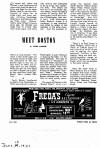
|
MEET BOSTON Friday, June 19, 1942 in What's New In Town W. J. Sidis |
By actual test, yellow and black is the combination of colors that gives the best visibility and legibility for signs. Boston used to use this combination for colors for its street signs, and many suburbs, including Cambridge, Watertown and Belmont still use those colors. Unfortunately, some fifteen to twenty years ago, the attempt was made here to imitate New York City street signs, with white letters on blue enamel. The result is that street signs are no longer easy to read, and the endurance of the new enamel signs is very low, so that many of them are already worn out and illegible, while the few old-time signs still left in Boston are as plain as they were forty years ago. Moral: Don’t imitate New York.
*
South Boston, transferred to Boston from Dorchester in 1804, was originally a real estate venture that attempted to set up a new, ritzy residential area. The streets are laid out in an unusually regular design, with a system of naming that followed pretty much the example of Washington, then newly built. Like Washington, South Boston’s streets are numbered in one direction, and called by letters of the alphabet in the opposite direction. And the example of Washington is even followed in skipping the letter J in the street alphabet. The idea of throwing in a “Broadway” as the main street was borrowed from New York, and was followed by another New York idea much later, namely, the division of streets into “East” and “West.” However, the numbering of streets in South Boston preceded that in New York by some twenty years.
*
The group of Neccos in the “Boston Wharf” district across the channel from South Station (Necco Street, Necco Place, Necco Court) might serve as a reminder that it was once the location of the New England Confectionery factory, now moved to Cambridge. And this, again, could call attention to the fact that most of the nationally known brands of candy are made in and around Boston―mostly in the Kendall Square region of Cambridge. So, wherever you are in America, if you have a sweet tooth, you are likely to be patronizing a Boston industry.
*
There is an Eslaf Street in West Roxbury, which has a Slavic or Turkish sound―until you think of the simple trick of spelling the name backward. Similarly, in Dorchester, there are such outlandish-sounding names as Navillus Terrace and Tebroc Street, which can be decoded in the same manner.
*
Near the water tower in West Roxbury are a number of streets with birds names. Included in this list are: Oriole Street, Linnet Street, Robin Street, Grouse Street, Larkhill Street, Bobolink Street, Heron Street and Partridge Street.